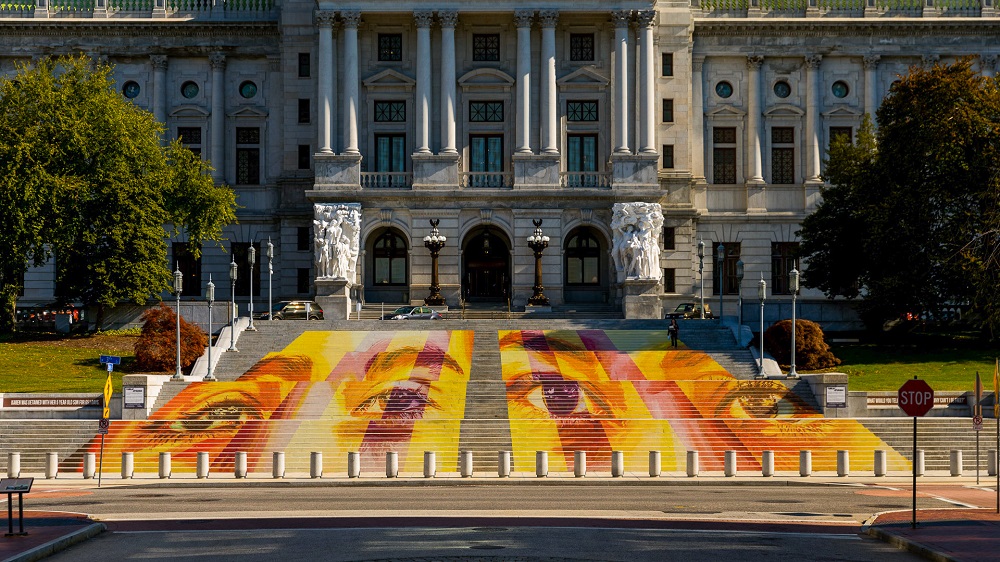(Photo credit: “Familias Separadas” Capitol Steps, Harrisburg, PA/ Artist Michelle Angela Ortiz/ Photo: Colibri Workshop.)
Our cultural heritage is filled with the works of writers and painters who aspire to create what Poe and others defined as “Art for Art’s sake”, a purely aesthetic endeavor where ideas are merely ornamental and the perfection of style and form and beauty is celebrated above all else. By contrast, there are many other artists for whom this notion is, at best, a luxury. For these individuals, Art is an indispensable tool for awakening what Lincoln eloquently referred to as “the better angels of our nature”, for prodding us to open our eyes wide to the inequities and injustices that surround us, paving the way for a corrective recalibration of society’s moral compass in response. These artists don’t dismiss aesthetic considerations completely; rather, they employ them in the service of some higher ethical or philosophical purpose. Dostoevsky, James Baldwin, and Diego Rivera are but a few examples of such artists. Michelle Angela Ortiz is another.
Take even a cursory glance at Ms. Ortiz’s portfolio, and one thing immediately stands out: the word “portfolio” doesn’t seem sufficient, because the canvases upon which she creates are vast, and her ambitions are equally prodigious. She aspires in her work to give voice to people who otherwise don’t have a readily accessible public platform through which to express their views. More specifically, she seeks to recognize and honor traditionally underrepresented communities, call attention to their situations, and eliminate the injustices that they endure. And, as her many projects make clear, she will stop at nothing within the infinite bounds of her Art to achieve these things.
What ICE euphemistically calls its “Berks Family Residential Center” is a case in point. Set amid the pastoral fields abutting Reading, PA, it seems tranquil and harmless enough on the outside. But inside, like its two infamous Texas siblings in Karnes and Dilley, the Berks Family Residential Center essentially serves as a long-term prison for migrant families, including children as young as two-weeks old, either seeking asylum or awaiting deportation. Disturbingly, it is also a facility where human rights abuses perpetrated by Center officials have occurred, to the point where, in 2016, the Pennsylvania Department of Human Services felt compelled to step in and revoke the Center’s license to house children, only to see it remain open as the legality of the revocation was challenged in court. Despite conditions in the facility that have been described as “unbearable” and “inhumane,” despite entire migrant families being held for years, and despite children reportedly being designated as “unaccompanied minors” and subsequently separated from their parents, the Berks Family Residential Center continues to operate today.
When Ms. Ortiz heard about the abuses occurring at Berks, she was outraged. And then she set to work. She first used her cinematic talents to produce a 30-minute documentary film that she titled, “Las Madres de Berks”, which profiles four mothers who were detained in Berks for nearly two years. In the film, the mothers discuss the horrors they endured while incarcerated with their families at the facility, including the pain of seeing their children suffer needlessly, to the point where some contemplated suicide.
The film became part of Ms. Ortiz’s larger “Familias Separadas” public art project, which aims to bring the plight of migrant families dealing with long-term imprisonment or facing deportation into the public consciousness. The project includes large murals created by Ms. Ortiz and set up in prominent places like the courtyard of Philadelphia’s City Hall and the streets in front of Philadelphia’s ICE Field Office building. It also involves a truly stunning, 88-foot long painting by Ms. Ortiz, composed of searing partial portraits of the four incarcerated migrant mothers profiled in “Las Madres de Berks” set side by side, boldly blanketing the steps of the Pennsylvania State Capitol Building in Harrisburg.
Ms. Ortiz’s goal in her work is not to offend those who oppose immigration or believe that detention centers are necessary evils, though she certainly has done that. Rather, she seeks to remind such people that the families being detained indefinitely, suffering in almost unimaginable conditions, are not statistics to be used for political manipulation or problems that can be hidden away from society and then “removed.” They are real, flesh and blood human beings. “I feel that if my art can help other people think differently and connect to each other to be reminded of our humanity,” she says, “then it is serving a good purpose.”
Amid the constant barrage of negative rhetoric and purposeful misinformation clouding the immigration landscape in the minds of many, one thing remains clear: we must use whatever skills and talents we have at our disposal to battle the injustices we see. Ms. Ortiz does this through her compelling artworks, but we can all participate in some way—whether by taking a case pro bono in our community, volunteering with the Immigration Justice Campaign on the ground or remotely, donating to local charities that help immigrants and disadvantaged populations, or the like. Even if we’re miles apart geographically, we can still come together in our altruism to do good.
****
If you’d like to learn more about Ms. Ortiz’s Familias Separadas Project and her other work, please visit her website. You also can stay updated on family detention issues by joining the “Shut Down Berks Coalition” and “Immigration Justice Campaign” Facebook groups.







